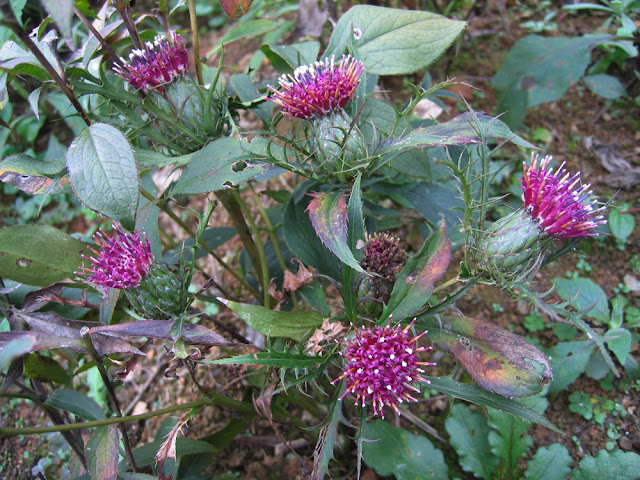Dies ist eine alte Version des Dokuments!
Atractylodes macrocephala Koidz. - Asteraceae - bái zhú 白术(朮) (chin.), largeheaded atractylodes
Prennial herb, up to 60cm tall, native to China, cultivated there; leaves alternate, 3-5parted, ovate-lanceolate, serrate, upper leaves not parted, 4-10cm long; flowers purplish, terminal.
http://www.efloras.org/florataxon.aspx?flora_id=2&taxon_id=200023528
The dried irregularly thick roots, which are used medicinally, have greyish-yellow to brown color, many warty protuberances and wrinkles/furrows and own a somewhat aromatic smell and sweet-pungent taste.
Indications are: „Polyuria, dysuria, stagnant water in the stomach, diarrhoea, oedema, night sweats, vomiting and unstale fetus in pregnancy.
[Medicinal plants in China: a selection of 150 commonly used species., World Health Organization., 1989, 48-49]
„Atractylodes Rhizome is officially listed in the Chinese Pharmacopoeia as the rhizome of Atractylodes macrocephala Roidz. (Fam. Compositae). The drug is collected in winter while the lower leaf of the plant turns yellow and the upper leaf becomes fragile, removed from soil, baked or sunned to dryness, and then removed from fibrous root. It is recommended in traditional Chinese Medicine as a digestive, diuretic and antihidrotic.“
http://duiyaoonline.com/herbs/baizhu.htm
„Oral administration of atractylenolide I and 14-acetoxy-12-senecioyloxytetradeca-2E,8E,10E-trien-4,6-diyn-1-ol produced significant anti-inflammatory effects in acute and chronic inflammation models in mice. The screening results with WBCM-C [white blood cell membrane (WBCM) chromatography (WBCM-C)] were correlated significantly with pharmacological effects in vivo. Atractylenolide I and 14-acetoxy-12-senecioyloxytetradeca-2E,8E,10E-trien-4,6-diyn-1-ol were the main components of Atractylodes macrocephala that were effective as anti-inflammatory agents.“
[Screening for the anti-inflammatory activity of fractions and compounds from Atractylodes macrocephala koidz., Li, C.Q., He, L.C., Dong, H.Y., Jin, J.Q., Journal of Ethnopharmacology, Vol.114(2), 2007, 212-217]
 atractylenoide I-III 8wikipedia)
atractylenoide I-III 8wikipedia)
„Five components were isolated and identified as atractylenolide III, atractylenolide I, 14-acetoxy-12-senecioyloxytetradeca-2E,8E,10E-trien-4,6-diyn-1-ol, 14-acetoxy-12-α-methylbutyl-2E,8E,10E-trien-4,6-diyn-1-ol and 14-acetoxy-12-β-methylbutyl-2E,8E,10E-trien-4,6-diyn-1-ol by routine spectrometric methods… Further in vivo experiments showed that the five components exhibited significant inhibiting effects both on the ear edema induced by xylene and on the peritoneal capillary permeability induced by acetic acid in mice.“
[Anti-inflammatory components isolated from Atractylodes macrocephala Koidz., Dong, H., He, L., Huang, M., Dong, Y., Natural product research, Vol.22(16), 2008, 1418-1427]
„Ten compounds were isolated from the dichloromethane extract of Atractylodes macrocephala and their aromatase inhibiting activities were tested using an in vitro fluorescent-based aromatase assay. The results indicated that atractylenolide I, atractylenolide II and atractylenolide III had inhibition ratios of 94.56 ± 0.70%, 90.93 ± 1.41% and 86.31 ± 8.46%, respectively, at a concentration of 10 μM. We conclude from our results that atractylenolide and its derivates may serve as potential aromatase inhibitors (AIs) and thus merit continued study in the future.“
[Screening for compounds with aromatase inhibiting activities from Atractylodes macrocephala Koidz., Jiang, H., Shi, J., Li, Y., Molecules, Vol.16(4), 2011, 3146-3151]

picture source: Λιούμπας Γιάννης, ΒΟΤΑΝΑ ΚΑΙ ΦΥΣΗ, http://votanakaifisi.blogspot.de/2012/12/atractylodes-bai-zhi-atractylodes.html
